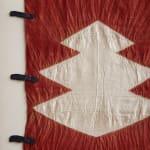Tie-dyed Banner with a Three-layered Diamond Shaped Crest on Vermillion Background
Tie-dyed silk, framed
Momoyama era (late 16th c.)
84 x 40 cm
102.5 x 57.5 cm (overall)
Momoyama era (late 16th c.)
84 x 40 cm
102.5 x 57.5 cm (overall)
A three-layered diamond-shaped crest is posited against a vermillion background on this tie-dyed banner. The crest is most famously related to the Ogasawara’s family.
With nearly all decorative elements omitted, the design of this banner highlights the tie-dyed family crest with a simple two-color pallete. Such attempt of focusing on one single purpose so as to reach the ideal of functional beauty leaves a deep impression to the viewers. The vermillion color attained from tie-dyeing and its subtle contrast to the white somehow create the three-dimensional effect of the family crest, which would silently expose the family dignity high behind a warrior or at the front of troops.
The art of dyeing, closely related to the field of costume, is deeply rooted in the aesthetics and life in different times. It is, thus, a fundamental element of the Japanese aesthetics. Such is recognized and highly praised by the Mingei leaders, including Yanagi Muneyoshi and Serizawa Keisuke, who manifested the beauty of dyeing widely. A banner of the same design is in the Japan Folk Crafts Museum. Another known example is favored by the famous essayist Shirasu Masako.
With nearly all decorative elements omitted, the design of this banner highlights the tie-dyed family crest with a simple two-color pallete. Such attempt of focusing on one single purpose so as to reach the ideal of functional beauty leaves a deep impression to the viewers. The vermillion color attained from tie-dyeing and its subtle contrast to the white somehow create the three-dimensional effect of the family crest, which would silently expose the family dignity high behind a warrior or at the front of troops.
The art of dyeing, closely related to the field of costume, is deeply rooted in the aesthetics and life in different times. It is, thus, a fundamental element of the Japanese aesthetics. Such is recognized and highly praised by the Mingei leaders, including Yanagi Muneyoshi and Serizawa Keisuke, who manifested the beauty of dyeing widely. A banner of the same design is in the Japan Folk Crafts Museum. Another known example is favored by the famous essayist Shirasu Masako.



